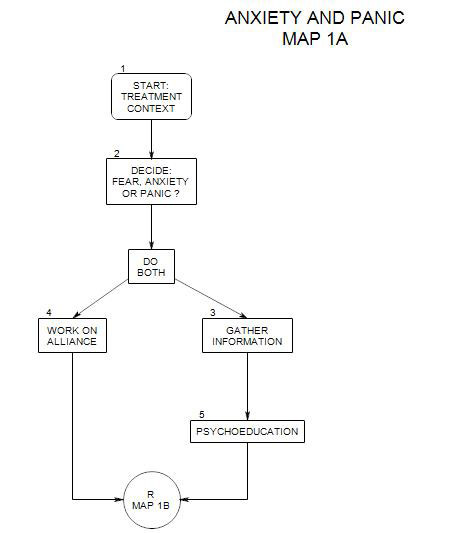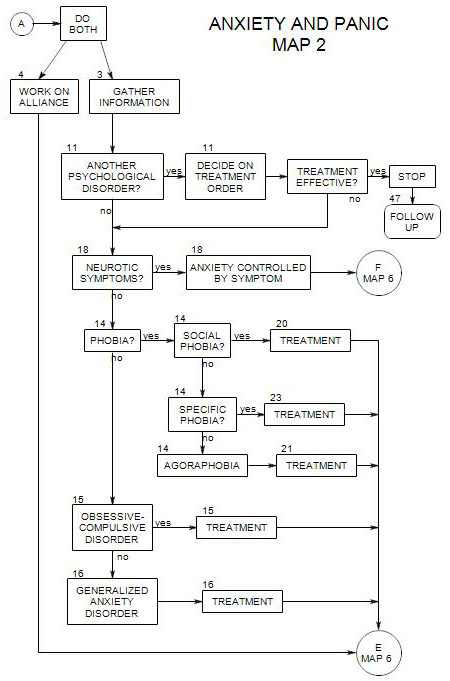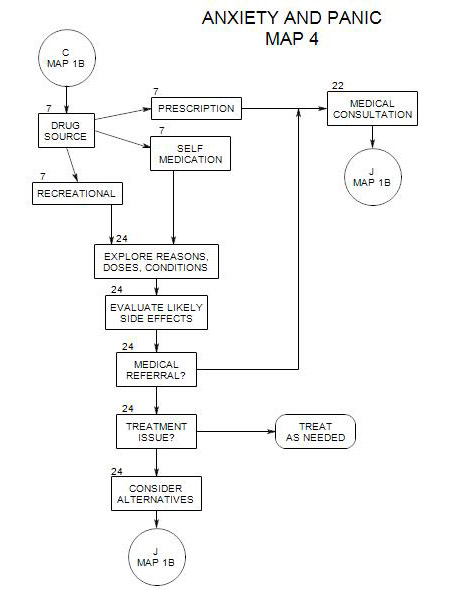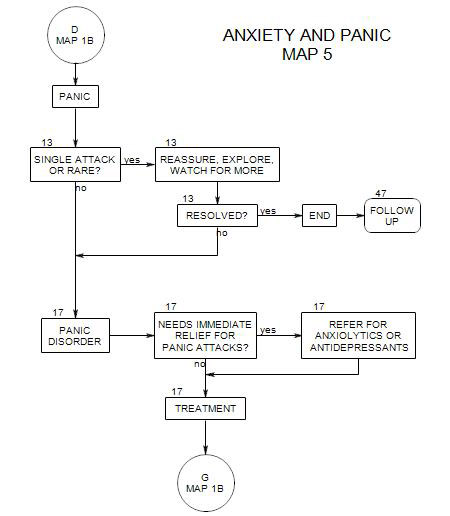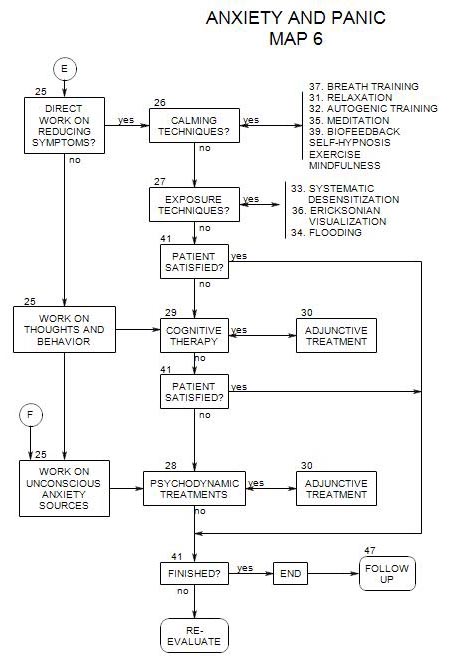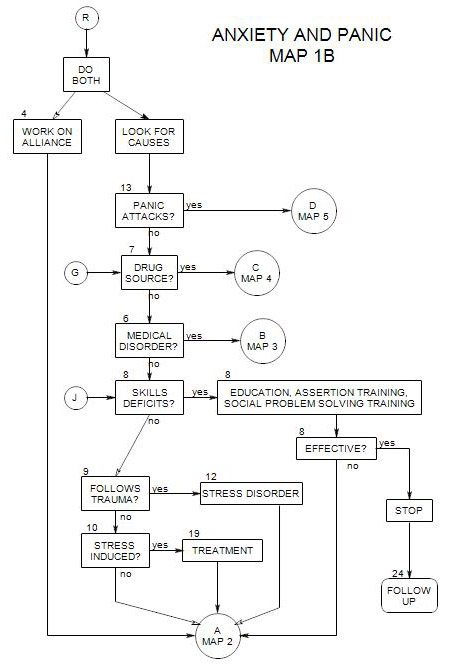
SECTIONS: 4 | 6 | 7 | 8 | 9 | 10 | 12 | 13 | 19 | 24
-
Follows Section 26, on Map 6
27a. General Principles
- Patients confront their fears directly, without trying to understand them or their origins.
- Exposure promotes both psychological and physiological habituation to the feared object or situation
- Eventually, the fear reaction subsides
- Because of increased freedom, the person’s life changes, often in unpredictable ways.
27b. Types of Exposure
There are two general approaches to exposure
- graduated or incremental exposure, the classic systematic desensitization approach. [ Section 33 ]. Here you first obtain a hierarchy of feared situations or objects, then help the person become more comfortable with item on the list, in order from least to most frightening.
- massed exposure to the most feared object or situation, usually known as flooding [ Section 34 ]. Here you begin with the most feared situation or object and reduce the person’s fear to that; after which his/her fears to all the other items in the hierarchy are also reduced.
Each of these approaches can be used in at least two ways, as discussed in Sections 33 and 34:
- with thoughts or images, in imaginal exposure
- using real life objects or situations, in in vivo exposure
- an intermediate situation uses controlled objects in the office or lab
Thus there are four broad classes of techniques: imaginal desensitization, in vivo desensitization, imaginal flooding, and in vivo flooding
The expression exposure and response prevention, is used to describe exposure when a person already engages in overt behavior to control his/her anxiety. You note the things the person does and prevent him/her from doing them during exposure. This is commonly used when describing treatment of obsessive-compulsive people, whose definitive symptoms have the function of alleviating anxiety. However, for patients with other diagnoses, the use of relaxation along with exposure is also designed to prevent the person’s usual response; so the term can be applied generally.
A fifth variation, Ericksonian Imaginal Desensitization [ Section 36 ], is less formal and designed to circumvent the patient’s defenses. Borrowing from the hypnotic techniques of Milton Erickson, it has the same goals as both flooding and systematic desensitization, of getting the person accept contact with the feared object or situation.
strong>27c. Exposure Techniques
This set of strategies involves placing the person in the presence of the feared thought, object or situation. Through direct experience, fear of the object or situation is extinguished and the person comes to be able to function effectively in its presence.
These techniques have several advantages:
- Because the focus is clearly defined by the procedure, it is relatively easy to determine whether treatment is effective (Wachtel, 1977, p.179).
- Fear is seen as learned reaction, so there is no implication that the patient is severely disturbed (Tuschen and Feigenbaum, 1997, p.36).
- Patient motivation is engaged in the treatment process (Tuschen and Feigenbaum, 1997, p.37).
- Treatment is relatively brief, compared to cognitive or uncovering treatments.
- There is a high success rate.
- The techniques of dealing with feared situations can be generalized to new situations by the patient.
On the other hand,
- the therapist can’t really control what the patient is thinking, and people’s attention can wander. Hence the treatment effectiveness can be reduced (Wachtel, 1977, p. 180).
- it is best not to use exposure when patient is defending against recognizing the actual sources of his/her anxiety, by being vague, coming up with “reasonable” explanations, etc. (Wachtel, 1977, pp. 191,192).
27d. Choosing Between Systematic Desensitization and Flooding
As compared to flooding, systematic desensitization has the following advantages:
- The process makes sense to both therapist and patient.
- It maintains a sense of cooperation between patient and therapist, and working together toward a common goal. Flooding may be jarring in the context of psychodynamic or cognitive therapy and threaten the primary form of treatment. (Wachtel, 1977, pp. 173, 191).
- Partial and intermediate progress gives a feeling of accomplishment.
- The procedure is less stressful to the patient. Because of that, there is less likelihood of a patient leaving in mid-session or refusing to return to subsequent sessions. There is also less likelihood of a person being overwhelmed and having his fear reinforced rather than reduced.
By comparison to systematic desensitization, flooding has the following advantages:
- It is often quicker and equally effective.
- It may be more effective if the patient’s complaints are vague, or confused, or seem to change from time to time (Wachtel, 1977, p.190).
By comparison with both systematic desensitization and flooding, Ericksonian Imaginal Desensitization has the advantage of being less controlling, so the patient’s defenses aren’t so easily aroused and the treatment can proceed unblocked (Wilson, 1996).
27e. Choosing Between Imaginal and In Vivo Exposure
By comparison with in vivo exposure, imaginal exposure has the following advantages:
- It is not necessary to actually come into contact with the situation or object itself [eg: being hit by a truck] This has practical implications. It also has value in avoiding the person’s resistance to facing real threatening situations. The person can entertain the possibility of change without actually facing it. [Wilson, 265]
- It can be carried out in the office when the real life situation can’t [eg: being mugged].
- The technique is very flexible with regard to range or stimuli, order of presentation, size of steps from one item to the next.
- Homework can be carried out anywhere.
- Variations can easily be arranged.
- The imagination is capable of creating images that you can’t replicate in vivo. [for acrophobia: standing on top of Mt. Everest. For fear of snakes: Lots of snakes; etc.].
By comparison with imaginal exposure, in vivo exposure has the following advantages:
- It immediately generalizes to the real world, because it takes place in the real world. Imaginal exposure may or may not (Wachtel, 1997, p. 180-182).
- It may be more effective for patients who have difficulty visualizing.
- It is generally more effective for many reasons, including the tendency of people not to be able to maintain continual focus on frightening thoughts, and the detail that real life presents. The patient wants to avoid thinking the very thing he/she must think in order for the treatment to be effective. This may undermine the effectiveness of the approach.
27f. Combinations
Although they may be studied and considered separately, in practice it is not uncommon to combine imaginal and in vivo techniques in the same individualized treatment plan.
